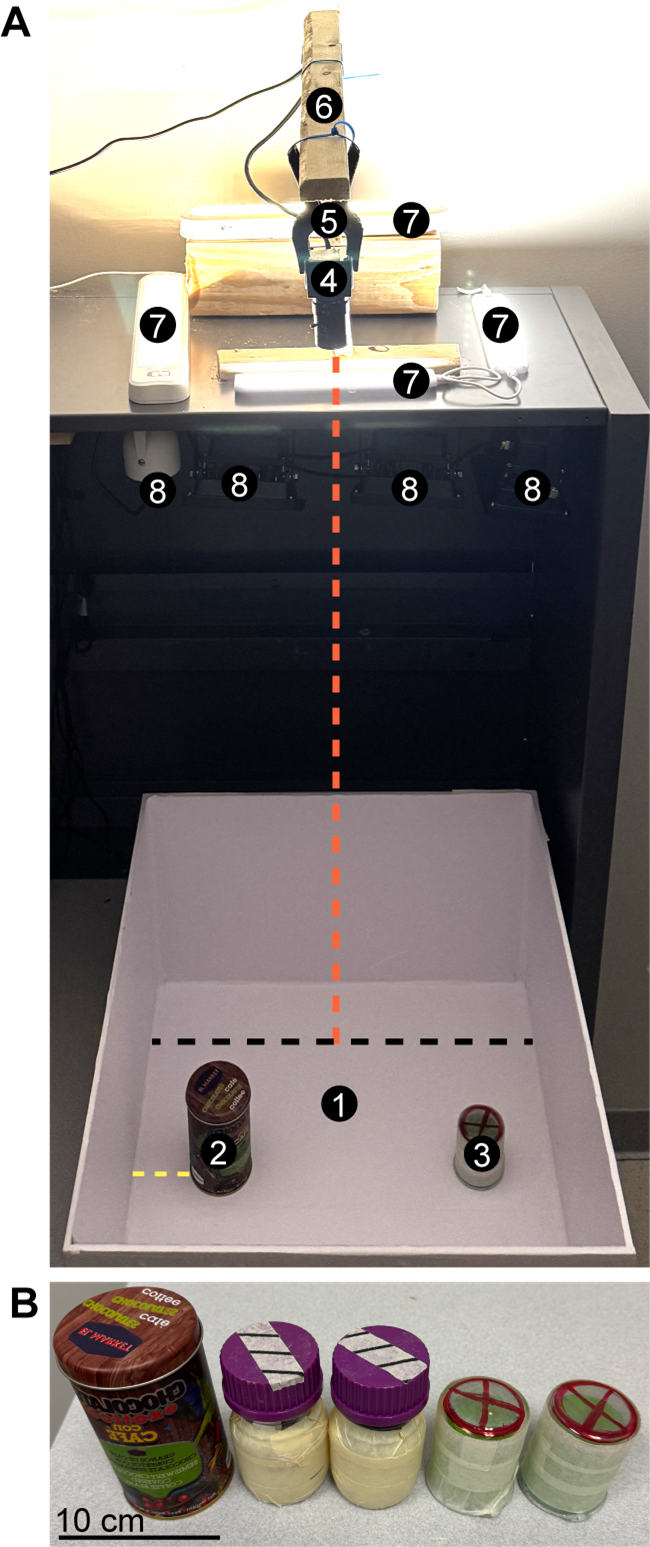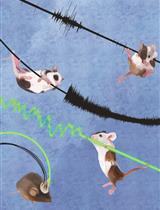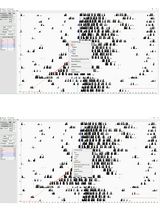- EN - English
- CN - 中文
A Protocol to Assess Time-of-Day-Dependent Learning and Memory in Mice Using the Novel Object Recognition Test
利用新物体识别实验评估小鼠学习和记忆的昼夜节律依赖性方案
发布: 2025年09月20日第15卷第18期 DOI: 10.21769/BioProtoc.5446 浏览次数: 2544
评审: Geoffrey C. Y. LauAnonymous reviewer(s)
Abstract
Changes in learning and memory are important behavioral readouts of brain function across multiple species. In mice, a multitude of behavioral tasks exist to study learning and memory, including those influenced by extrinsic and intrinsic forces such as stress (e.g., escape from danger, hunger, or thirst) or natural curiosity and exploratory drive. The novel object recognition (NOR) test is a widely used behavioral paradigm to study memory and learning under various conditions, including age, sex, motivational state, and neural circuit dynamics. Although mice are nocturnal, many behavioral tests are performed during their inactive period (light phase, subjective night) for the convenience of the diurnal experimenters. However, learning and memory are strongly associated with the animal’s sleep-wake and circadian cycles, stressing the need to test these behaviors during the animals’ active period (dark phase, subjective day). Here, we develop a protocol to perform the NOR task during both light (subjective night) and dark (subjective day) phases in adult mice (4 months old) and provide a flexible framework to test the learning and memory components of this task at distinct times of day and associated activity periods. We also highlight methodological details critical for obtaining the expected behavioral responses.
Key features
• Enables analysis of learning and memory in mice during both active (dark) and inactive (light) phases.
• Allows for switching the time-of-day-dependent familiarization and recognition to study the impact of activity and sleep-wake cycle on cognitive performance.
• Details the environmental and experimenter-dependent conditions that can impact behavioral responses.
• Provides a flexible, adjustable platform for testing variable experimental conditions such as age, sex, learning and memory components, and genetic manipulations.
Keywords: Behavioral assay (行为学检测)Graphical overview

Time-of-day-dependent novel object recognition (NOR) test. Complete workflow of the experiment, including 3 days of testing during light or dark phases (left panel), video recording (middle panel), data analysis, and visualization of the results (right panels).
Background
Behavioral testing in rodents enables evaluating multiple aspects of cognitive processes, including attention, learning, memory, spatial navigation, fear, and anxiety, under both normal and pathological conditions [1,2]. These tests vary in complexity and structure, with some exploiting animals’ natural instincts (such as escape from danger [3] or grooming [4]) and others employing complex training sessions to elicit learned responses (such as maze navigation [5] or pellet reaching [6]). The novel object recognition (NOR) test is routinely utilized to quantify learning and memory in mice, relying on their inherent drive to explore objects within their environment [1,7–9]. The test involves two sessions where a mouse freely explores an arena. Initially, the arena contains two identical objects for familiarization. In the second session, one object is replaced with a novel object. It is expected that the mouse's natural curiosity will lead it to spend more time exploring the novel object, providing a measure of its learning and memory. NOR is a powerful paradigm due to its high degree of flexibility and adaptation to various experimental questions, for example, to quantify short-term vs. long-term memory, or to examine how different environmental conditions (such as time of day) or genetic perturbations (such as gene knockouts) impact these cognitive processes [10,11]. Importantly, mouse behavioral performance may be influenced by stressors such as light and noise [12], underscoring the importance of carefully calibrating the testing parameters to enable reliable, measurable responses.
Cognitive function is strongly influenced by the light/dark cycle and circadian clock [13,14]. The circadian clock is an intrinsic rhythm-generating system consisting of transcriptional-translational feedback loops involving core clock genes, which maintain a 24-h periodic regulation of multiple aspects of physiology, including cognition [15–17]. Numerous studies across various species including flies, rodents, and humans have shown that learning and memory abilities vary by time of day [13,14,18–27], while circadian disruptions due to altered light/dark or feeding cycles (such as jet lag or clock gene dysregulation) result in impaired cognitive performance in several behavioral tasks [28–37], including the NOR test [10,11]. Importantly, the NOR test offers a unique advantage for studying clock-related cognitive function as it enables separate investigation of learning and memory components like consolidation and recall by varying the time of day of object familiarization and recognition. Since circadian disruptions are linked to cognitive disorders such as depression [38–40] and Alzheimer’s disease [41–43], designing robust experimental paradigms to study the underlying mechanisms is crucial for advancing our understanding of these disorders and for developing novel treatments.
Here, we describe a protocol for the NOR test that is modified [8,10,11,44] to quantify time-of-day-dependent learning and memory in mice. The test consists of three consecutive days (24 h interval) and includes habituation (day 1; no objects), familiarization (day 2; identical objects), and testing (day 3; novel object; see Graphical overview). Moreover, the habituation day serves as an “open-field test” [1] to assess time-of-day-dependent locomotion and general anxiety. This protocol is highly flexible and can be adapted to test the effects of light/dark cycle and circadian clock perturbations on learning as well as both short-term and long-term memory. This protocol also provides insights and troubleshooting suggestions to ensure robust and reproducible results.
Materials and reagents
Biological materials
1. Adult (4 months old) wild-type mice (C57BL/6J background; Jax #000664) of both sexes were used for validation experiments. Sex differences in behavioral performance were not observed under these experimental conditions; thus, the data were pooled. All mice used for these experiments were born and raised in the laboratory’s mouse colony in the vivarium space.
Reagents
1. 200 proof pure ethanol (Koptec, catalog number: 89125-172 or similar)
Caution: This chemical is flammable.
Solutions
1. 70% ethanol
Recipes
1. 70% ethanol
| Reagent | Final concentration | Quantity or Volume |
|---|---|---|
| 200 proof pure ethanol | 70% | 350 mL |
| diH2O | 30% | 150 mL |
Laboratory supplies
1. Paper towels (Georgia-Pacific, catalog number: B0017TKE8G or similar)
2. 500 mL spray bottle (VWR, catalog number: 10216-884 or similar)
Equipment
1. Testing arena size 53 L × 45 W × 30 H cm custom-made from white 7328/WRT30 cast 32% translucent acrylic sheets (Interstate Plastics, catalog number: ACRW8CPSH; see General notes)
2. Webcam (varifocal lens USB webcam, ELP, Link, or similar)
3. Wide-angle infrared (IR) illuminators (850 nm wide-angle illuminator) (Univivi, Link, or similar)
4. LED light bars (under cabinet lights) (Ezvalo, Link, or similar)
5. 4-inch spring clamp (4-inch heavy duty plastic spring clamp) (Yesker, Link, or similar)
6. Zip ties (8-inch cable ties) (Skalon, Link, or similar)
7. Overhead camera stand (custom made, see General notes; Figure 1A)
8. Objects for exploration test (see General notes and Troubleshooting section; Figure 1B): 100 mL beakers (100 mL griffin low form glass beaker, VWR, catalog number: 10754-948); 250 mL bottles (250 mL media/storage bottles with GL screw caps, VWR, catalog number: 10754-816)
9. Computer capable of recording videos (in this protocol, a Dell Optiplex desktop computer equipped with Windows 10, 32 GB RAM, 1 TB SSD, Intel Core i7 processor, and USB 3.0 ports was used)
10. Matte white wallpaper (solid white wallpaper, Homeease, Link, or similar)
11. Odor-free adhesive (removable mounting putty LJ8XP, Scotch, Link, or similar)

Figure 1. Novel object recognition (NOR) test setup. (A) Setup for behavioral testing, including the testing arena (1) shown with two different objects (2–3) placed a minimum of 5 cm away from the arena wall (yellow dashed line). The location of the objects remains constant throughout experimental days. A camera (4) is mounted above the arena (5–6: camera holders) at a distance of 96.5 cm from the arena floor (red dashed line). Camera height can be adjusted as needed, depending on camera type and setup, as long as the entire arena is within the field of view. Illuminators for both daytime (7, visible light) and nighttime (8, infrared light) are arranged as shown, avoiding direct illumination of the arena (especially important for visible light; see General notes and troubleshooting). The black dashed line corresponds to the arena width, 45 cm. (B) The different objects used for the NOR test in this protocol. On day 2 of the experiment, two identical objects are placed in the arena. One of the objects is replaced with a novel/different object on day 3 (as shown in A). Scale bar = 10 cm.
Software and datasets
1. MATLAB (version R2025a, MathWorks; may be free with student license)
a. Add-on: Curve-Fitting Toolbox version 25.1
b. Add-on: Image Processing Toolbox version 25.1
c. Add-on: Signal Processing Toolbox version 25.1
d. Add-on: Statistics and Machine Learning Toolbox version 25.1
2. Python (version 3.10.16; Python Software Foundation)
3. Conda (version 24.11.3, Anaconda Software Distribution)
4. DeepLabCut (version 3.0.0 [45,46])
5. BehaviorDEPOT (version 1.6 [47])
6. Chronotate (version 1 [48])
7. Excel (Microsoft) or Google Sheets (Google, free)
8. All the code used in this protocol is available on this GitHub page
Procedure
文章信息
稿件历史记录
提交日期: Jun 12, 2025
接收日期: Aug 6, 2025
在线发布日期: Aug 27, 2025
出版日期: Sep 20, 2025
版权信息
© 2025 The Author(s); This is an open access article under the CC BY license (https://creativecommons.org/licenses/by/4.0/).
如何引用
Mar, J., McGregor, M. A., Raghuraman, V. and Farhy-Tselnicker, I. (2025). A Protocol to Assess Time-of-Day-Dependent Learning and Memory in Mice Using the Novel Object Recognition Test. Bio-protocol 15(18): e5446. DOI: 10.21769/BioProtoc.5446.
分类
神经科学 > 行为神经科学 > 学习和记忆
神经科学 > 行为神经科学 > 睡眠与觉醒
您对这篇实验方法有问题吗?
在此处发布您的问题,我们将邀请本文作者来回答。同时,我们会将您的问题发布到Bio-protocol Exchange,以便寻求社区成员的帮助。
Share
Bluesky
X
Copy link











